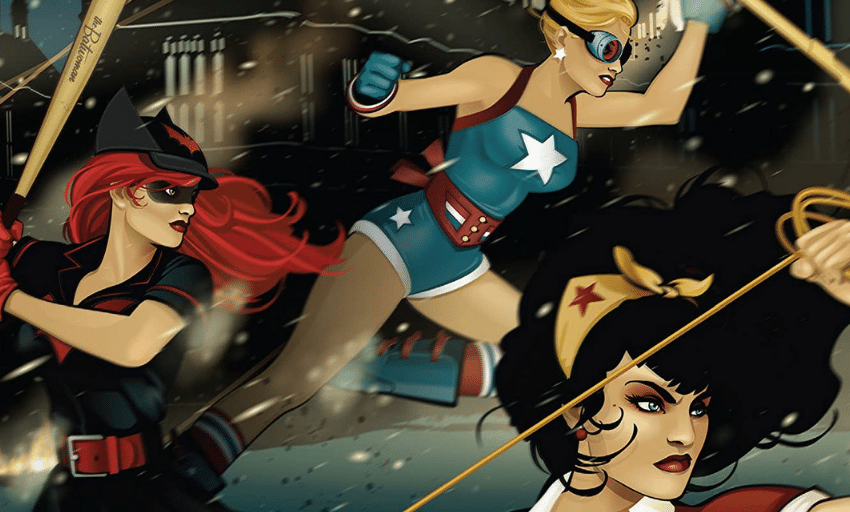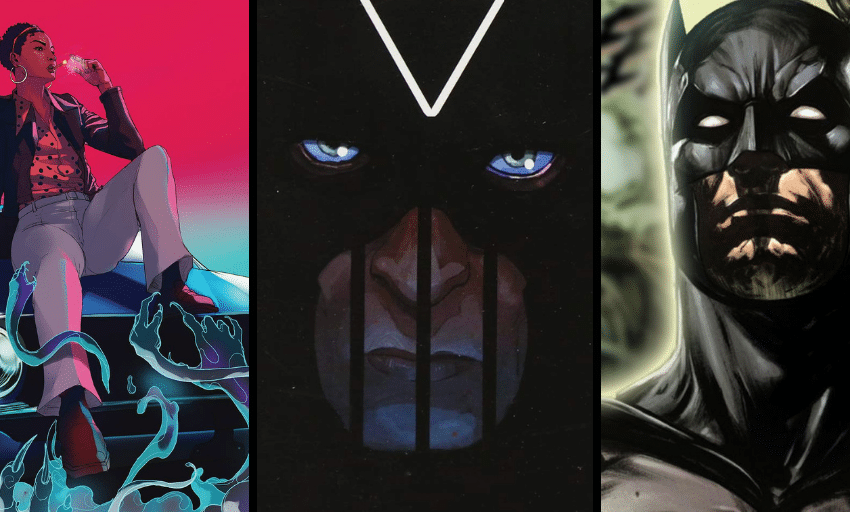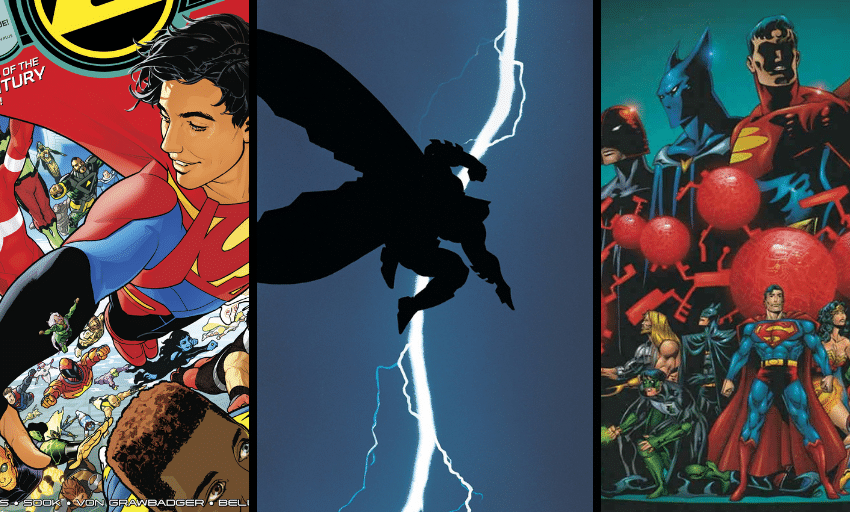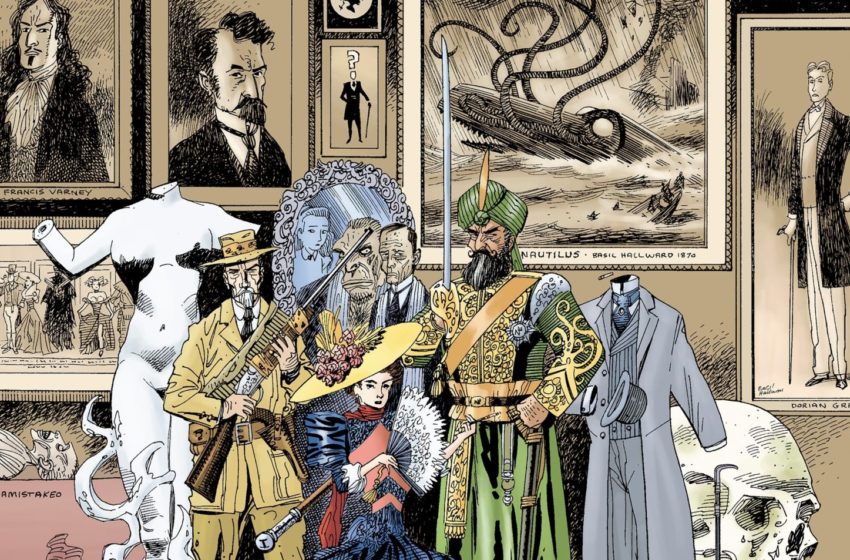Last week, to no fanfare, DC released the final trade paperback of the newest volume of Lucifer. This would normally be unsurprising, since trade collections are released every week and usually garner no attention. However, this volume was different: None of this material had been released before in any format. This final arc was another victim of last spring’s industry shutdown, and only now was being released. The series, from rising star and site favorite Dan Watters (Home Sick Pilots, Picture of Everything Else), was a horror book in the style of classic Vertigo, and was a highlight of the Sandman Universe imprint. With that in mind, this week’s Bonus Reading looks at four of DC’s devils, Lucifer included.
Lucifer Morningstar

“Why do they blame me for all their little failings? They use my name as if I spent my entire days sitting on their shoulders, forcing them to commit acts they would otherwise find repulsive. ‘The devil made me do it.’ I have never made one of them do anything. Never. They live their own tiny lives. I do not live their lives for them.” — Lucifer Morningstar, The Sandman: Season of Mists
There are very few devils like Lucifer Morningstar, the ruler of Hell at the beginning of Neil Gaiman, Sam Kieth and Mike Dringenberg’s The Sandman. Visually inspired by David Bowie, Lucifer first appeared in issue #4 of the series, when Dream of the Endless makes his trip to Hell. And when Dream returns in Season of Mists, he finds Lucifer closing up the place. Lucifer is done with ruling Hell. He was never evil, the great tempter of the Bible. No, Lucifer stood against God’s grand plan. He wanted the thing humanity was given: freedom of choice. And at this point in his existence, Lucifer has chosen to give up his post and live on Earth. He pops up one last time in The Sandman, owning a piano bar, Ex Lux, in Los Angeles, and that in itself would have been an interesting ending for the character.
But that was not the end of Lucifer. Of all the characters created in The Sandman, with the possible exception of Death of the Endless, no other character has had as much of an impact outside the original run than Lucifer. He has headlined three different ongoing series. The first, written by Mike Carey and drawn principally by Peter Gross, is a book in scope equal to The Sandman. Starting with Lucifer doing a job for Heaven, it quickly becomes a series about Lucifer becoming god to his own creation, and soon spirals into a conflict involving gods of the Japanese and Norse pantheons, angels, demons, the Lillim and eventually Yahweh himself. Trying to describe the sweep of what Carey does over 79 issues (the core 75, a three-issue prequel mini under The Sandman Presents banner and a prestige-format one-shot) would be impossible in such a short piece; it is modelled after the kind of storytelling Gaiman did in The Sandman, with characters coming in and out, plotlines slowly building and a well-researched mythology.
The other two Lucifer ongoings did not last as long but were interesting in their own ways. Volume 2, initially written by Holly Black and then by Richard Kadrey, two writers better known as novelists, was released in the twilight years of DC’s famed Vertigo imprint. Timed to coincide with the debut of the Lucifer TV series, this one picks up after the end of the original ongoing. Yahweh has been murdered, and Lucifer is the chief suspect. An entertaining series, it only lasted 19 issues and never got off its feet, but is worth tracking down if you are a fan of the character.
The final as-of-today volume of Lucifer rolled out as part of DC’s Sandman Universe imprint. Written by Watters with art principally by Max and Simon Fiumara, this series ignores or sidesteps all non-Gaiman written stories (as did all the Sandman Universe stories, for good or ill) and takes Lucifer in another direction. The series opens with Lucifer blind and without his powers, imprisoned and without his memory. The series’ four arcs are very distinct, and Watters builds with each arc improving on the last toward a stunning climax that I hope more people read.
I recommend The Sandman Universe Classics: Lucifer Vol. 1, collecting the first half of Carey’s run.
The First of the Fallen

If you prefer your devils more classically evil and truly horrifying, your best bet within DC is the First of the Fallen, created by Garth Ennis in his breakout run on John Constantine, Hellblazer. The First was created to be the ruler of Hell, Satan, but because of the events of The Sandman, Ennis had to tinker with his concept to fit the First into a universe with a Lucifer who already existed.
The First was the first being God created, before there were angels or mortals. He was created to be His companion, and more than that, an externalization of God’s own conscience, or so Constanine deduces. But when the First began to question the mental stability of the almighty, he was cast down into what would become hell. The First was soon joined by other fallen, and ruled Hell in a triumvirate before Lucifer took the throne. But with the departure of Lucifer, the First and his brothers returned as Hell’s ruling triumvirate; this of course doesn’t acknowledge some of the other aspects of Sandman, but Vertigo continuity was always a loose thing. The First is actively at war with God and embodies and embraces sin and evil, even if he’s doing so to fight an unjust and possibly insane creator.
The First encountered Constantine for the first time at the home of Constantine’s friend Brendan Finn. Brendan had sold his soul to the First for the greatest wine cellar ever, and now that he was dying, the First had come to collect. But Constantine, ever the bastard, tricked the First into drinking holy water, delaying him long enough for midnight to pass, and due to a clause in the contract, Brendan got to go to heaven. This … displeased the First, as one might imagine, and he was planning to get his revenge when John died of the lung cancer that was ravaging his body, but when the First arrived to claim the mage’s soul, he found John had tricked him once again. John had sold his soul to both the Second and the Third of the Fallen, the other of Hell’s rulers, and the three would have to go to war to decide who would possess the soul, thus weakening their forces in any fight with Heaven. To prevent this, the three great lords of Hell cured Constantine, but this only guaranteed the enmity the First held for him.
The First became Constantine’s main foil for the balance of Ennis’ run on Hellblazer. Over and over again, John bested the First, and his rage grew. Finally, the First decided to kill the other members of the triumvirate, thus releasing their hold on John’s soul and allowing the First to claim it. But, as ever, Constantine had an angle: This was all a long con. John’s demonic ally, the succubus Ellie, was able to kill the First using a dagger forged from the bodies of his two former brothers, and John had finally won.
Or as much as anyone wins in comics. The First would appear again during Paul Jenkins’ run on the title, where he was revealed to have been forced into a mortal form. By the end of that run, the First had reclaimed the throne of Hell. He would appear a few more times over Carey and Peter Milligan’s run, and would continue to vex Constantine, but he was never quite the epic threat he was during that initial run.
I recommend Hellblazer: Dangerous Habits, the quintessential Hellblazer story and John’s first meeting with the First, and Hellblazer: Rake at the Gates of Hell, the conclusion of Ennis’ run.
Neron

Both DC and Marvel have a problem with devils: They have too damn many of them. I mean, if you look at the X-Factor arc “The Hell on Earth War,” you can see most of Marvel’s Hell lords in combat, ranging from Mephisto — probably the most famous — to Satannish, who is just sort of … satanish. DC had a few demons in its main continuity — since Vertigo tends to stand slightly outside the main DC Universe — but none of them was The Devil in caps. That was until the 1995 crossover Underworld Unleashed, where DC introduced Neron.
While there are plenty of demons who are just plain evil in superhero comics, and who lust after the souls of mortals, Neron has a particular shtick. He is a demon who makes deals, what is called a Contract Devil in D&D and Pathfinder or a crossroads demon on Supernatural. Neron is always looking to convince someone to give him their soul in a Faustian pact, one that often has a monkey’s paw-esque twist to it. In his initial appearances, Neron got a large number of supervillains to sell him their souls for enhanced powers, all in a gambit to get the purest soul of all: Captain Marvel’s [Grote’s note: aka Shazam]. But when Captain Marvel willingly took a deal to save his fellow heroes from Hell for an altruistic reason, Neron could not hold onto the soul and was defeated.
After Underworld Unleashed, Neron became something of a rarity in the DC Universe: a powerful villain with no particular hero as his arch enemy. He would fight the Flash by deploying soulless undead Rogues, he would join with a rogue angel to fight the Justice League, he tried to make a deal to get Richard Dragon’s soul, and he was tricked by Ralph Dibney and trapped in the Tower of Fate. If none of this sounds very impressive, that’s because it really isn’t. Neron is a fairly bland villain, with no motivation other than being a bad guy, and he was created for an event even the writer of which says failed in most respects. But hey, he has a trademark neon green color that was used for that series that exists outside the normal four-color comic book printing process. As ’90s cover gimmicks go, that one … doesn’t really rank. Frankly, with very few exceptions, all the deals Neron made were quietly retconned or ignored, so it’s safe to ignore them and him most of the time.
I recommend Midnighter and Apollo by Steve Orlando and Fernando Blanco. After being killed, Apollo’s soul is damned to Hell, and Midnighter must go and retrieve it from Neron’s clutches. It’s a love story with supernatural and superhero elements, and Midnighter gets to beat the hell out of Neron, so that’s fun.
Blue Devil

So you know how I said most of Neron’s deals were retconned and ignored? Well, we’re going to get into one that wasn’t in this entry.
Blue Devil didn’t start out as a devil. Nope, Blue Devil, created by Dan Mishkin, Gary Cohn and Paris Cullins, was created to be a Marvel-style hero in the DC Universe, a hero with a tragic backstory who becomes something of a hard-luck, happy-go-lucky do-gooder. Dan Cassidy was a special effects artist and stuntman who was wearing a full body exosuit and costume when the set he was on was attacked by a demon. Using the suit’s enhanced strength, Dan was able to stop the demon, but a blast of mystical energy bonded the suit to Dan, trapping him in it (How he went to the bathroom trapped in that suit was never addressed, as far as I know). Dan initially tried to find a way out of the suit but eventually came to love his life as a superhero.
After his series ended in the mid-’80s, Blue Devil faded into obscurity, appearing in crossovers and guest appearances until the ’90s, when happy-go-lucky heroes were no longer the norm. When Underworld Unleashed happened, Blue Devil was one of the few heroes who made a deal with Neron, trading his soul and a single act of destruction for fame. But destroying the unmanned power station inadvertently causes the death of Marla Bloom, an old friend of his, and it is that tragedy that gains him notoriety again. Joining other heroes to fight Neron, Blue Devil is killed only to be reborn as an actual demon.
Blue Devil would go on to join the Justice League for a brief time, and then after dying and coming back again, would become a member of the short lived magical-team the Sentinels of Magic, and the longer-lived one, the Shadowpact. He finds friendship among the Shadowpact, especially with Detective Chimp and Nightmaster. When the New 52 reboot occurred, Blue Devil’s origin was rewritten and connected with Black Lightning’s, but neither character really appeared in that universe again, and both would pop up again during the Rebirth era. In the Rebirth Justice League Dark, Blue Devil would be the guardian of the mystical land of Myrra after the death of Nightmaster and the abandonment of the duty by Detective Chimp. There’s no word on whether he’ll be popping up in Infinite Frontier.
I recommend Blue Devil Annual #1, a wacky team-up issue where Blue Devil joins Creeper, Man-Bat, Black Orchid, Etrigan and some other horror-y heroes to fight Felix Faust.
Matt Lazorwitz read his first comic at the age of five. It was Who's Who in the DC Universe #2, featuring characters whose names begin with B, which explains so much about his Batman obsession. He writes about comics he loves, and co-hosts the creator interview podcast WMQ&A with Dan Grote.






